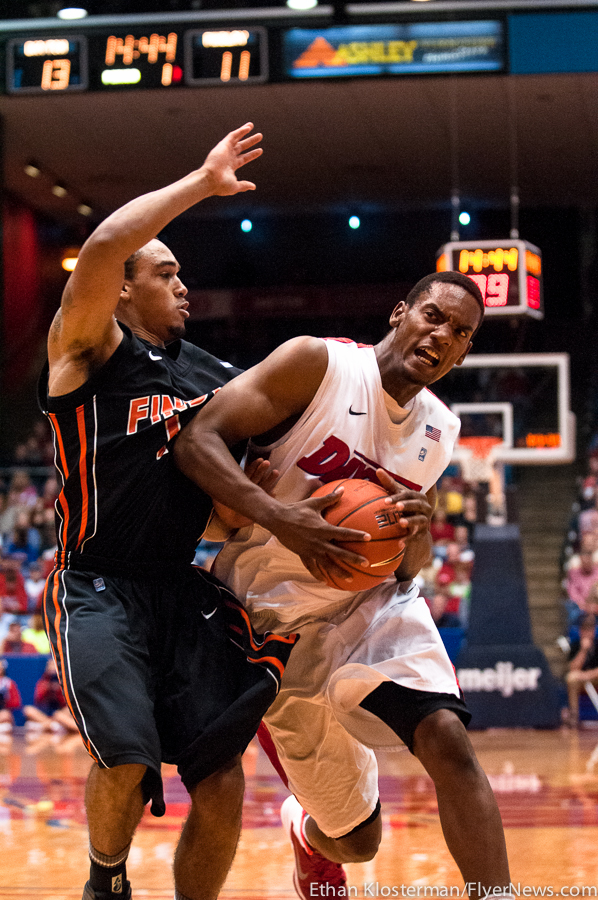EARLY FOCUS ON NEW HAND-CHECKING RULE

University of Dayton sophomore forward Dyshawn Pierre (21) is fouled on the way to the basket during an exhibition game against the University of Findlay, Saturday, Nov. 2, at UD Arena. UD won 96-87. (Ethan Klosterman/Photo Editor)
By: Steven Wright – Sports Editor
Seventy fouls and 96 free throws in one game.
Those were the numbers from the University of Dayton men’s basketball team’s exhibition contest against the University of Findlay Saturday, Nov. 2, at UD Arena.
It was not just an anomaly for what the trend could be this season either. Basketball fans should prepare themselves for the incoming wave of enforcement of defensive rules instructed by the NCAA to officials this season.
“We were waiting on it,” Dayton head coach Archie Miller said. “We played the Red-Blue game and it was touchy. We played our Ryerson game and it was a little bit touchy, wasn’t called the same. Tonight was one of those things that I think everybody was really anticipating, how the game is going to get called.”
The NCAA sent out a video to head coaches across the country in early October outlining how it plans to stress calling hand-checking plays by defensive players in a stricter manner.
The new written rule states a defensive player keeping his hand or forearm on an opponent, putting two hands on an opponent, jabbing at an opponent with a forearm, or using an arm to impede a ball dribbler’s progress will be whistled immediately for a foul.
“The whole hand checking thing, we’re trying as a team and individually as players to adjust because I feel like for a lot of us, it’s in the back of our heads not to get the foul, so we just kind of let the offensive players score,” redshirt senior guard Vee Sanford said after the Findlay game. “You all saw the refs were pretty quick to blow the whistle. Each player is trying to get over that but it’s hard.”
Four players were disqualified from foul trouble between Findlay and Dayton Saturday, and another six ended the game with four fouls. A pair of freshmen forwards, Dayton’s Kendall Pollard and Findlay’s Tyler Stern-Tucker, were the only players not called for multiple fouls.
“It’s amazing,” senior forward Devin Oliver said. “We’re complaining about a lot of them, and some of them could have been bad, but you can’t blame the refs. We have to learn to adjust in the change to the way they’re calling it, because that’s the new rules, and that’s how it’s going to be.”
Most of the reaction to the new emphasis has been toward the defensive side of the ball, but Sanford said he knows how it can affect the offensive portion of a team’s attack too. Dayton presents itself as a team that likes to drive and be aggressive toward the basket, creating numerous fouling opportunities already.
“That’s the double-edged sword,” Sanford said. “You get to the foul line, but you don’t want the other team to get to the foul line a lot as well. It’s a whole adjustment thing.”
There are other rule changes this season, including clarification on block-charge calls. Rule 4-17.4.d states a defender must now be set in his position prior to the ball handler going “airborne” to shoot or pass to establish a legal guarding position, which should help decrease the amount of fouls seen as “flops” during a game.
Also, elbows above the head that are deemed incidental can now be called as only a common foul and not automatically flagrant. Officials are also no longer required to give a visible 10-second count for back-court violations, with the shot clock being used to count instead, unless it’s not available.
The hand-check call has been the takeaway though from exhibition games around the country. The first real look at its effect will come on the first day of the regular season around the country Friday, Nov. 8, and for Dayton Saturday, Nov. 9, against Indiana Purdue-Fort Wayne.
According to Miller, the game has already changed. He doesn’t see it as a bad thing though, with his team being able to learn more about its own depth and getting players in spots they wouldn’t normally be used to playing on the floor.
Miller said he knows 70 fouls and 96 free throw attempts bring a new challenge to navigate through.
“That’s a good thing for us because we got to learn a little bit about how it’s going to get called at different times,” Miller said. “… That’s a lot of different rotations in the flow of the game. So we’re going to have to look at it and I think the big thing is … being able to show the opportunities on what we can and can’t do. How do we prevent those things from happening.”

